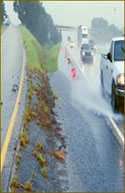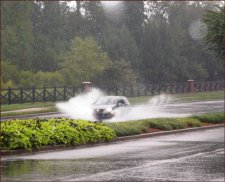For service in the Atlanta, Georgia area contact or call us:
What is Hydroplaning?
Hydroplaning lifts the tires of a vehicle off the pavement. When the tires are lifted from the pavement, you do not have steering or braking control of your car. This is dangerous. Hydroplaning vehicles run off of the roadway or crash into other vehicles.
When your vehicle's tires lose contact with the roadway, you cannot steer your vehicle and you cannot brake.
Hydroplaning Accidents
Remember the time you were driving along the highway in the late afternoon in the summer when a thunderstorm suddenly drops buckets of rain out of the sky?
This photograph shows a section of roadway on Interstate 75 in Georgia. You will see in the photograph the amount of spray from the vehicles. This spray is created when cars and trucks travel through water that has accumulated on the travel path of the roadway.
Spray decreases the visibility for the other drivers on the roadway. Not only does the spray create a danger to the other drivers, but is an indication that an excessive amount of water is on the roadway.

After a very serious accident, I evaluated the roadway. My client wanted to know if the water on the roadway contributed to the accident. And if it did, how did the water affect the driver's ability to control his vehicle?
I found two problems. First, I determined that water could not get off the roadway because of the minimum amount of cross
slope.The cross slope was very flat and was not capable of discharging the water to the side of the roadway in an efficient manner.
Second, a portion of the roadway had a curb and gutter section along the outside travel lane. The slope of the curb and gutter caused water to flow into the travel lane instead of away from the travel lane. The curb and gutter were incorrectly constructed with a negative slope instead of a positive slope.
Roadway Defects
During my career, I have evaluated many roadway pavement surfaces for drainage defects. I have found 3 basic sources of roadway defects. They are:
- Poor maintenance,
- Poor construction or
- Poor drainage design.
- Poor maintenance is the leading source of roadway defects involving surface water drainage. For example, the storm drainage system getting stopped by debris, trash and silt. Also, drainage catch basin get clogged with debris.
- Each of us has seen ruts in the travel lane made by vehicles. Water gets in the ruts and flows down the roadway instead of flowing to the side of the highway. A weak subgrade or a weak asphalt mix usually causes this situation.
- Poor construction or sloppy construction techniques will cause roadway defects. Roadway need to be crowned to discharge stormwater from the roadway. Inadequate cross slope will cause water to stay on the roadway longer and the longer it stays on the roadway, the deeper it will be.
- Poor design of drainage will cause water staying on the pavement surface. An example would be a design of the roadway without sufficient number of catch basins along a curbed street. In one of my cases, the street had no catch basins in the sag of a vertical curve. Water was trapped in the sag after every rain.
Loss of Control
Due To Hydroplaning
It is a tragic situation when a vehicle hits an unexpected pool of water on the roadway. The driver's sudden loss of control of his vehicle is scary and frightening.
Most vehicles recover and the driver continues down the roadway. For the drivers that do not recover, the results are usually disastrous, especially on a busy highway. The vehicle collides with another vehicle or runs off the road.
Drivers lose control of their vehicles because water accumulates in front of the tires and lifts the vehicle's tires off the pavement surface. The tires lose contact with the pavement. This may be a partial loss of contact or a complete loss of contact with the roadway.
When this happens, the driver of the vehicle has no control over steering or braking. The car will continue in the direction it was headed. The lucky drivers recover before hitting an object such as an oncoming vehicle or run off the road.
Factors in Hydroplaning
Some of the factors which cause hydroplaning are:
|
|
Professional Hydrologists

We are Professional Hydrologists, Hydroplaning Specialists, Professional Engineers, and certified Accident Reconstruction Engineers and Professional Surveyors.
For hydroplaning accidents, contact Elvin Aycock at 678-297-2565.
Further Reading About Hydroplaning
Hydroplaning caused by roadway defects
Qualifications of a good hydroplaning expert
Hydroplaning article written by Elvin Aycock for the American Institute of Hydrology.
Home Page - Atlanta Engineering Services
Ruts cause hydroplaning where the asphalt and the subgrade has failed.
Hydroplaning on roadways while transiting from superelevation to normal crown
Pavement drainage can be a problem in vertical curve sags and in transitions from superelevations to tangent sections.
More pavement drainage problems occur when the centerline crown is destroyed and superelevation transitions hold water.
G-ZNJ8QW23K9
